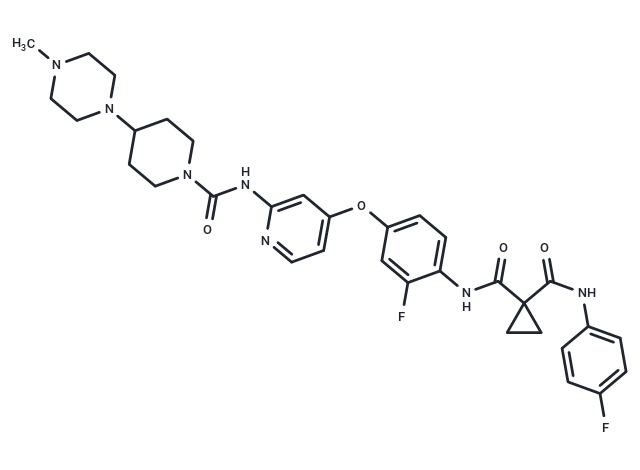Shopping Cart
- Remove All
 Your shopping cart is currently empty
Your shopping cart is currently empty

Golvatinib (E-7050) is an orally bioavailable dual kinase inhibitor of c-Met (hepatocyte growth factor receptor) and VEGFR-2 (vascular endothelial growth factor receptor-2) tyrosine kinases with potential antineoplastic activity. c-Met/VEGFR kinase inhibitor E7050 binds to and inhibits the activities of both c-Met and VEGFR-2, which may inhibit tumor cell growth and survival of tumor cells that overexpress these receptor tyrosine kinases. c-Met and VEGFR-2 are upregulated in a variety of tumor cell types and play important roles in tumor cell growth, migration and angiogenesis.

| Pack Size | Price | Availability | Quantity |
|---|---|---|---|
| 2 mg | $38 | In Stock | |
| 5 mg | $61 | In Stock | |
| 10 mg | $93 | In Stock | |
| 25 mg | $159 | In Stock | |
| 50 mg | $207 | In Stock | |
| 100 mg | $369 | In Stock |
| Description | Golvatinib (E-7050) is an orally bioavailable dual kinase inhibitor of c-Met (hepatocyte growth factor receptor) and VEGFR-2 (vascular endothelial growth factor receptor-2) tyrosine kinases with potential antineoplastic activity. c-Met/VEGFR kinase inhibitor E7050 binds to and inhibits the activities of both c-Met and VEGFR-2, which may inhibit tumor cell growth and survival of tumor cells that overexpress these receptor tyrosine kinases. c-Met and VEGFR-2 are upregulated in a variety of tumor cell types and play important roles in tumor cell growth, migration and angiogenesis. |
| Targets&IC50 | VEGFR2:16 nM, c-Met:14 nM |
| In vitro | In vitro studies indicate that E7050 potently inhibits phosphorylation of both c-Met and VEGFR-2. E7050 also potently represses the growth of both c-met amplified tumor cells and endothelial cells stimulated with either HGF or VEGF. [1] E7050 circumvents resistance to all of the reversible, irreversible, and mutant-selective EGFR-TKIs induced by exogenous and/or endogenous HGF in EGFR mutant lung cancer cell lines, by blocking the Met/Gab1/PI3K/Akt pathway in vitro. E7050 also prevents the emergence of gefitinib-resistant HCC827 cells induced by continuous exposure to HGF. [2] |
| In vivo | In vivo studies using E7050 shows inhibition of the phosphorylation of c-Met and VEGFR-2 in tumors, and strong inhibition of tumor growth and tumor angiogenesis in xenograft models. Treatment of some tumor lines containing c-met amplifications with high doses of E7050 (50–200 mg/kg) induces tumor regression and disappearance. In a peritoneal dissemination model, E7050 shows an antitumor effect against peritoneal tumors as well as a significant prolongation of lifespan in treated mice. [1] In another xenograft model research, tumors produced by HGF-transfected Ma-1 (Ma-1/HGF) cells are more angiogenic than vector control tumors and shows resistance to ZD1839. E7050 alone inhibits angiogenesis and retards growth of Ma-1/HGF tumors. E7050 combined with ZD1839 induces marked regression of tumor growth. [3] |
| Kinase Assay | Western blot analysis: The phosphorylation status of c-Met and VEGFR-2 is detected by Western blot analysis. For c-Met, MKN45 cells are incubated with a serial dilution of E7050 in complete medium at 37 °C for 2 h. For VEGFR-2, HUVEC are starved with human endothelial serum free medium containing 0.5% FBS for 24 h. Subsequently HUVEC are incubated with a serial dilution of E7050 for 1 h and then incubated with 20 ng/mL of human VEGF for 5 min. Cells are lysed by lysis buffer (50 mM HEPES [pH 7.4], 150 mM NaCl, 10% glycerol, 1% Triton X-100, 1.5 mM MgCl2, 1 mM EDTA [pH 8.0], 100 mM NaF, 1 mM phenylmethylsulfonyl fluoride 1 mM sodium orthovanadate, 10 μg/mL aprotinin, 50 μg/mL leupeptin, and 1 μg/mL pepstatin A). The resected tumor samples are homogenized with lysis buffer containing 25 mM β-glycerophosphate and 0.5% (v/v) phosphatase inhibitor cocktail 2 at 4 °C. Cellular debris is removed by centrifugation at 17 860 g for 20 min at 4 °C. Aliquots of the supernatants containing 5-20 μg of protein are subjected to SDS-PAGE under reducing conditions. The proteins are then transferred onto PVDF membranes, blocked with TBS containing 0.05% Tween-20 and either 5% skim milk or 5% BSA. The membranes are probed with the following antibodies: anti-c-Met polyclonal antibody (C-28) and anti-VEGFR-2 polyclonal antibody (C-20); mouse anti-phosphotyrosine clone 4 g10; and anti-VEGFR-2 polyclonal antibody, anti-phospho-VEGFR-2 (Tyr996) polyclonal antibody, and anti-phospho-c-Met (Tyr1234/1235) polyclonal antibody. Detection is performed using a Super Signal enhanced chemiluminescence kit. Immunoreactive bands are visualized by chemiluminescence with an Image Master-VDS-CL detection system. The intensity of each band is measured by using an image analyzer. |
| Cell Research | Cells (1–3 × 103 cells/100 μL/well) are seeded on 96-well culture plates with various concentrations of E7050 and cultured for 3 days. Then, 10 μL of WST-8 reagent is added to each well, and absorbance is measured at 450 nm compared with a reference measurement at 660 nm using a MTP-500 microplate reader. HUVEC (2 × 103 cells/well) are cultured for 3 days in medium containing HGF (30 ng/mL), VEGF (20 ng/mL), or basic fibroblast growth factor (bFGF) (20 ng/mL) together with serially diluted E7050.(Only for Reference) |
| Alias | E-7050 |
| Molecular Weight | 633.69 |
| Formula | C33H37F2N7O4 |
| Cas No. | 928037-13-2 |
| Smiles | CN1CCN(CC1)C1CCN(CC1)C(=O)Nc1cc(Oc2ccc(NC(=O)C3(CC3)C(=O)Nc3ccc(F)cc3)c(F)c2)ccn1 |
| Relative Density. | 1.408 g/cm3 |
| Storage | Powder: -20°C for 3 years | In solvent: -80°C for 1 year | Shipping with blue ice. | |||||||||||||||||||||||||||||||||||
| Solubility Information | H2O: < 1 mg/mL (insoluble or slightly soluble) Ethanol: < 1 mg/mL (insoluble or slightly soluble) DMSO: 100 mg/mL (157.81 mM) | |||||||||||||||||||||||||||||||||||
Solution Preparation Table | ||||||||||||||||||||||||||||||||||||
DMSO
| ||||||||||||||||||||||||||||||||||||

Copyright © 2015-2025 TargetMol Chemicals Inc. All Rights Reserved.